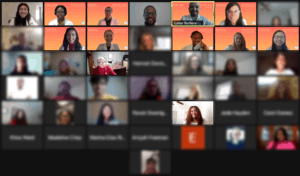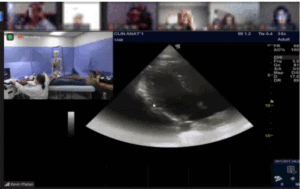Virtual Recruitment Shows Students Pathways, Possibilities in Health Care
| Over 50 high school students from across Arkansas spent a recent Saturday morning listening to UAMS students talk about preparing for careers in health care.
“Since we knew that our audience was high school students who were willing to wake up early on a Saturday to attend a virtual program, we knew they probably had a higher level of interest in health care. We wanted to give them a little bit more than just ‘entertainment,’” said Alexandra Diaz-Cruz, a UAMS student in the colleges of Medicine and Public Health and one of the event organizers.

High school students from all across Arkansas were able to speak directly with UAMS medical students during the virtual HPREP event.
Though usually held on the Little Rock campus, the annual event, called the Health Professions Recruitment and Exposure Program, was held virtually for the first time this year. It aims to reach underrepresented minority students and those who will be the first in their family to attend college.
In other words, students like herself, said Diaz-Cruz.
“As a first-generation college student, I was always in survival mode, with little opportunity to plan ahead because I did not know what I was supposed to be doing in the first place,” she said. “This can be the case for a lot of minority students who are very capable of completing a career in health care but may be deterred by obstacles that are not even related to academics.”
Presented by UAMS’s Edith Irby Jones chapter of the Student National Medical Association, the event included advice on all the steps leading up to applying for college and advanced degree programs; input from admissions officials in the colleges of Medicine, Nursing and Pharmacy; and potential training and employment opportunities for high school graduates and working college students interested in health careers.
The UAMS Division for Diversity Equity and Inclusion (DDEI) intentionally created summer pipeline programs to expose underrepresented minority students at all levels to health career pathways. This summer is no exception, with an array of virtual programs offered. Visit the website for more information and to apply.
“Having clinical experience before applying to a program is highly valuable, so we introduced that concept,” said Diaz-Cruz, who added that participants were provided a handbook with information on where to find training and summer employment opportunities, as well as research internships and academic preparation programs.
The day’s event also included a demonstration from ArkanSONO and Kevin Phelan, Ph.D., a professor in the College of Medicine’s Department of Neurobiology and Developmental Sciences, who demonstrated sonogram scanning of the heart, abdomen and arms.

The sonogram demonstration allowed students to see the demonstration as it also displayed results of the scan.
At the end of the day’s event, attendees also got to participate in a panel discussion and Q&A session with UAMS students who spoke about their journeys from high school to medical school.
“It’s important for people to realize you can draw a straight line from events like this to patients living longer, healthier lives,” said Nick Pettus, manager of diverse student recruitment in the UAMS Division for Diversity, Equity and Inclusion. “Including people from a variety of backgrounds, hometowns and socioeconomic situations makes for better classrooms, research labs and clinics. Diversity makes a health care workforce better.”
But the nature of diversity outreach is important, noted Diaz-Cruz.
“If we really want to increase diversity in health care, we have to meet students where they are in life and realize that their pathway is probably not going to look like what is traditionally expected,” she said.
